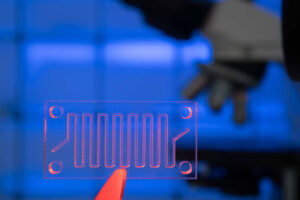What is Organ on a Chip and How Does it Work?
An Organ-on-a-Chip (OOC) is a multi-channel 3D microfluidic cell culture chip that simulates the functions, activities, mechanics, and physiological response of entire organs and organ systems. OOCs are a type of artificial organ. This technology merges lab-on-a-chip with cell biology allowing for the study of human physiology in an organ-specific context. The goal of OOCs is to hopefully one day eliminate the need for animal testing during drug trials and toxin testing.
How do Organ-on-a-Chip Work?
Organ-on-a-chip are designed to recreate the physiological response of individual organs or entire organ systems. The chips are lined with living human cells and the microfluidic channels reproduce blood and/or air flow just as the human would do. The flexibility of OOCs allow the chips to recreate breathing motions or muscle contractions.
Each organ chip is about the size of a AA battery. These chips can be used to replicate the functions of organs such as lungs, liver, intestines, or the brain. Because the chips are transparent, researches are able to see the organ’s functionality, behavior, and response at the cellular and molecular level.
How are Organ-on-a-Chip Systems Used?
Organ-on-a-Chip are placed into a research system; similar to a computer. But this device is specifically designed to recreate the human body’s living environment (i.e. blood flow and breathing). Scientists use these instruments to introduce medicines, chemicals, and other toxins to the chip’s environment to test the organs response and behavior.
In some cases, OOCs can be connected together. This allows scientists to observe how different organ systems react/interact, thus providing a better understanding of the impact the different foreign substances might have on the human body.
Organ-on-a-Chip and Drug Testing
Throughout the advent of modern medicine, drug trials have been conducted on animals. Animal models were the only method of obtaining live data that would predict human physiological responses. The downside to animal testing is that trials are often lengthy, expensive, and can be controversial. Furthermore, concerns have been raised as to validity of results from animal testing due to deficiency in cross-species extrapolation.
Therefore, a need arose to mimic human organ and organ systems physiological responses to outside stimuli. And this wasn’t just a need to eliminate the use of animal models; animal trials are lengthy and expensive. Organ-on-a-chip technology is significantly more affordable, scalable, and results can be reproduced at a fraction of the cost as well as in a fraction of the time compared to animal models. Thus, biomimetic microfluidic systems could (and should) replace the need for animal testing. The development of these systems, that recreate organ-level pathological responses, could revolutionize multiple fields of study, including toxicology and development of pharmaceuticals which rely heavily on clinical trials.
Citrogene: Organ-on-a-Chip Engineers
Citrogene has developed a proprietary process that allows for the manufacture at scale organ-on-a-chip devices at an affordable price. Our manufacturing process provides a quick turn-around time from receipt of your design to the finished product. Contact us today, or submit your organ-on-a-chip design, to learn more.

